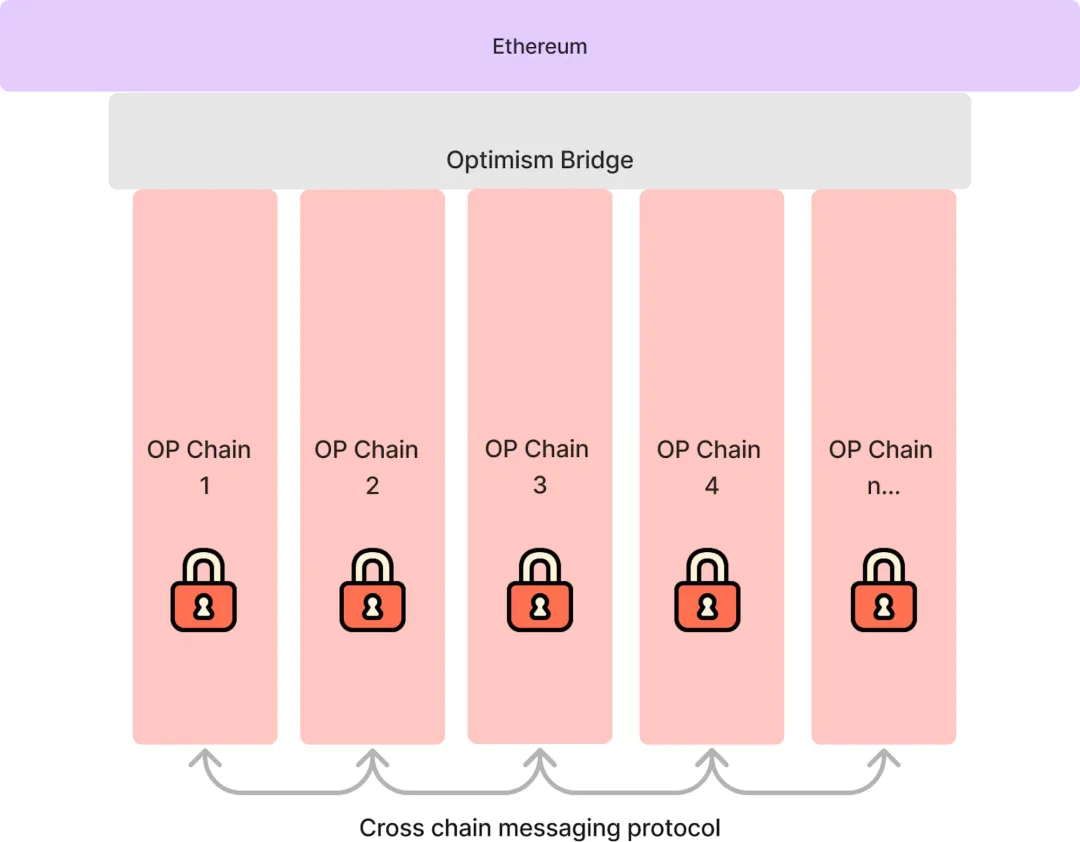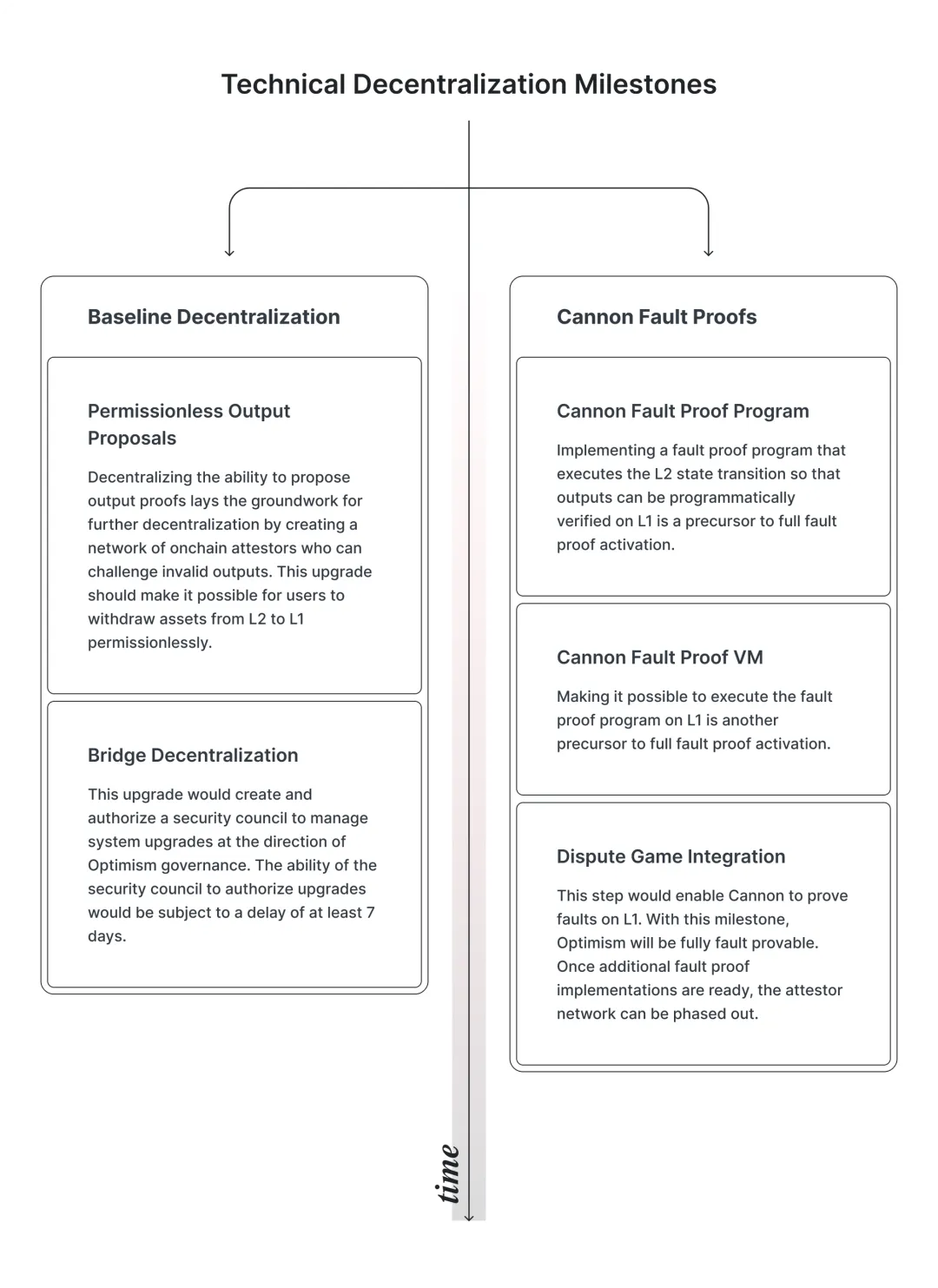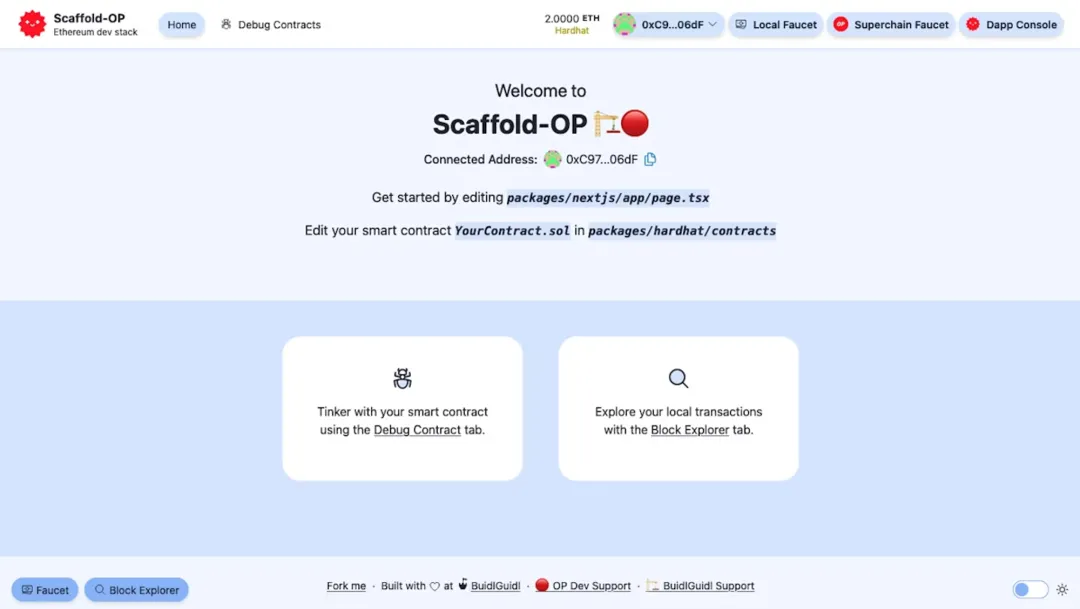Introduction
Last month, the WorldCoin Foundation announced the launch of the World Chain, a blockchain based on the OP Stack. This blockchain will be integrated into Optimism's superchain, Superchain, and will interact with other chains such as Base, Mode, OP Mainnet, and Zora.
You may have heard of OP, OP Stack, and the superchain. Curious readers may ask: What? Why? Where? This article will answer these questions one by one, discussing the current status and vision of the superchain, among other topics. At the end of the article, a one-click deployment process for L2/L3 will be provided.
Starting with Optimism
You are certainly familiar with Optimism, a Layer 2 solution based on Ethereum, aimed at providing fast, stable, scalable, and cost-effective blockchain services. By running on top of the Ethereum main chain (Layer 1), Optimism helps alleviate network congestion, reducing transaction costs and processing time.
Optimism utilizes a technology called Optimism Rollups, which bundles a large amount of transaction data together and processes and pays for it only once on the Ethereum main chain. This method not only speeds up transactions and reduces costs but also maintains high security based on Ethereum. Later, the Optimism Rollup technology was open-sourced and became part of the OP Stack - an open-source blockchain framework announced by the Optimism Collective.
OP Stack can be understood as a toolbox for one-click L2 deployment, greatly simplifying the construction of L2 chains. These decentralized L2 chains developed based on OP Stack share security, communication layers, and open-source technology stack, forming the vision of the OP superchain.
Current Status - Deployed in Various Fields Using OP Stacks
Currently, OP Stacks has been adopted by several well-known projects, including Base, which currently dominates various L2 NFT trading data, Coinbase's Layer2, the asset management application Debank Chain developed by Debank, and the social leading protocol Farcaster's Farcaster Stack. The diversity of these applications reflects the concept of the OP superchain that OP Stack aimed to support from the beginning.
What is a "Superchain"?
A "superchain" is a multi-chain network structure based on Layer 2 (L2) technology, designed to address the horizontal scalability challenges of traditional blockchains. Traditional multi-chain architectures often face difficulties in collaboration and high costs, while the "superchain" treats each chain as "interchangeable computing resources," allowing developers to build cross-chain applications without increasing systemic risk.
In the "superchain" model, each chain (such as the OP chain) is standardized and integrated into the network formally managed by the Optimism Collective. These chains not only share security and communication layers but also share an open-source technology stack. This design allows developers to focus on building applications across the entire superchain without worrying about the specific technical details of individual chains, making the concept of blockchain itself more abstract and providing new possibilities for the future development of blockchain.

Furthermore, this design concept also means that the concept of blockchain itself can become more abstract, allowing developers to view the entire interoperable blockchain network as a unified entity, making it more efficient to develop and deploy new solutions. In this way, the "superchain" not only optimizes resource utilization but also provides new possibilities for the future development of blockchain.
How Does OP Chain Ensure Security
In the security model of the "superchain" bridging, security (i.e., validity) and liveness (i.e., censorship resistance) are guaranteed. Security is ensured by the proof system, and liveness is ensured by the ability to submit transactions directly to L1. The combination of security and liveness means that if the OP Chain sequencer malfunctions, users can always submit transactions to L1, and L1 will migrate their usage to a new OP Chain with a properly functioning sequencer.
Below is the official definition of the "superchain" by Optimism. It is considered a "superchain" if it meets the following conditions:
Attributes
Purpose
Shared L1 blockchain
Provides complete ordering of transactions for all OP chains, i.e., the sequencer.
Shared bridging for all OP chains
Provides standardized security attributes for OP chains.
Low-cost deployment of OP chains
Allows deployment and transactions on OP chains without incurring high L1 transaction fees.
Configuration options for OP chains
Allows OP chains to configure their data availability providers, sequencer addresses, etc.
Secure transactions and cross-chain messages
Enables users to securely migrate data between OP chains.
OP Technology's "Decentralization" Route
OP Labs, as the framework support, has made many efforts to make OP Stack support a wider range of decentralized technologies. For example, the Bedrock version supports multiple proof schemes and multiple clients. The failure proof of multiple clients is a fundamental part of technical decentralization, and the modular framework of Bedrock has greatly influenced the community's practical decentralized capabilities for OP Stack development.
Strategy - Maintain Honesty
In the pursuit of decentralization, it is important to maintain intellectual honesty in the face of challenges. Specifically, writing complex and error-free code is very difficult but crucial, as any vulnerability could have catastrophic consequences for any L2.
Strategy - Parallel Development of Protocol Upgrades
OP advocates maintaining purposeful, pragmatic, and cautious steps in on-chain failure proofs. Achieving complete proofs takes time, but Optimism believes that several protocol upgrades can be developed in parallel to further develop OP Stack in a meaningful way towards decentralization without waiting for the readiness of failure proofs.
Keeping up with technical solutions has actually led to the discovery of two bugs in OP by the Arbitrum team recently [1]. As a technical provider, this widely used open-source framework is subject to scrutiny by the market and the community at any time and needs to take on more responsibility.

Timeline and Milestones of Technical Decentralization
Successful Commercial Deployment of OP Stacks Superchain
According to L2Beat data, as of May 4, 2024, the total value locked (TVL) in Layer 2 amounted to $399.8 billion, with OP Stack accounting for $186.1 billion, nearly half of the total TVL and ranking first. Optimism's Stack services have been widely adopted, with more and more projects using the OP Stack framework to quickly build a new L2, such as Optimism, Base, Mode, Zora, Frax, Lyra, Ancient, Redstone, Worldcoin, Mint, and Lisk. This highlights the value of Stack services in the market narrative.
How Did OP Stacks Evolve into a Superchain?
From a technical perspective, we have removed a portion of the code and official information to answer this.
Introduction of the SystemConfig contract
The technical platform behind OP Stack, Bedrock, has introduced the SystemConfig contract, which directly defines L2 chains through L1 smart contracts. This can be extended to include all information defining L2 chains on-chain, including generating unique chain IDs, block gas limits, and other key configuration values. An excerpt of the SystemConfig contract is as follows [2]:
/** * @title SystemConfig * @notice The SystemConfig contract is used to manage configuration of an Optimism network. All * configuration is stored on L1 and picked up by L2 as part of the derviation of the L2 * chain. */contract SystemConfig is OwnableUpgradeable, Semver { /** * @notice Enum representing different types of updates. * * @custom:value BATCHER Represents an update to the batcher hash. * @custom:value GAS_CONFIG Represents an update to txn fee config on L2. * @custom:value GAS_LIMIT Represents an update to gas limit on L2. * @custom:value UNSAFE_BLOCK_SIGNER Represents an update to the signer key for unsafe * block distrubution. */ /* * @notice Minimum gas limit. This should not be lower than the maximum deposit gas resource * limit in the ResourceMetering contract used by OptimismPortal, to ensure the L2 * block always has sufficient gas to process deposits. */ uint64 public constant MINIMUM_GAS_LIMIT = 8_000_000; /** * @notice Identifier for the batcher. For version 1 of this configuration, this is represented * as an address left-padded with zeros to 32 bytes. */ bytes32 public batcherHash; /** * @notice L2 gas limit. */ uint64 public gasLimit;
CREATE2 Generates Deterministic Chain Addresses
Based on the SystemConfig design, once all data is fully on-chain, a factory (Chain Factory) can be created to deploy configurations and all other necessary contracts for each chain. By using CREATE2 to generate corresponding contract addresses, we further extend this step: this means that given a chain configuration, we can determine all bridge addresses associated with that chain. This also allows interaction with the chain without deploying bridge contracts, making chain deployment almost free and allowing the chain to inherit standard security attributes.
Communication Between OP Chains - "Chain Factory" Adopts OP Chain Data
Bedrock has introduced a method for establishing L2 chains from L1 chains, where all chain data can be synchronized with L1 blocks. As the L1 chain factory expands to put all configurations on-chain, Optimism nodes can deterministically synchronize any OP chain with just an L1 address and a connection to L1.
It is important to note that when the synchronization of OP chains is complete, the chain state is locally computed. This means that determining the state of OP chains is completely permissionless and secure. Since all invalid transactions are ignored by the local node computation process, derived chains do not require a proof system. However, to ensure withdrawals on the Superchain, a proof system is still required.
Modular Design of Sequencers Using SystemConfig
Bedrock introduces the functionality to set sequencer addresses in the SystemConfig contract. With the introduction of multiple chains with their own SystemConfig contracts, deployers can configure sequencer addresses for OP chains. This configurable sequencer design is called modular sequencing. This allows different entities to sequence OP chains while retaining the standard [Superchain bridge] security model - a key step towards decentralizing sequencers.
Modular sequencing allows experimentation with different sequencing models without permission. Developers can adopt various sequencing protocols, such as round-robin sequencing, sequencer consensus protocols, price-competitive sequencing (PGA sequencing), or first-in-first-out sequencing (FIFO sequencing). Over time, we can expect more user-friendly sequencing standards to emerge.
Shared Technical Upgrade Path for OP Chains
To confidently launch the initial Superchain in terms of security and decentralization, a decentralized security committee should be introduced to manage upgrades. The security committee should be able to update the chain prover set, initiate delayed contract upgrades, and, in emergency situations, press the bridge pause button while canceling ongoing upgrades.
The ability to pause the bridge in emergency situations means that in the worst-case scenario, i.e., if the private keys of the security committee members are compromised, the result will be an indefinite suspension of withdrawals, and bridge upgrades will be permanently canceled. In other words, the L1 bridge will be frozen. This follows the design principle of prioritizing security over liveness - i.e., preventing the loss of ETH or tokens (enforcing security), even if it means locking ETH or tokens (sacrificing liveness).
Pain Points on the Road to OP Stack Becoming a "Superchain"
Of course, there are still some important pain points to be addressed before fully realizing the vision of a scalable blockchain and becoming a superchain. The anticipated pain points include:
Withdrawal requests relying on a set of trusted chain provers.
Slow cross-chain transaction speed, requiring a challenge period.
Insufficient scalability for submitting transactions to the Superchain, as transaction data must be submitted to the limited capacity of L1.
Asynchronous cross-chain transactions, which disrupt the ability to execute atomic cross-chain transactions (such as flash loans).
This has been improved after EIP4844.
Lack of a user-friendly framework to build scalable applications using multiple OP chains.
Lack of a simple wallet to manage tokens and applications across multiple OP chains.
We envision that when these pain points are resolved, we will be able to build decentralized alternatives that can replace the most complex web2 applications.
Mass Adoption of Superchain After 4844?
The introduction of EIP-4844 almost synchronously with the Delta upgrade of the Optimism ecosystem is a perfect match.
Data availability (DA) solutions such as Celestia are primarily aimed at reducing the cost of submitting data from rollups to L1, while 4844 provides a native solution that reduces the operating costs (OPEX) of OP chains by over 90%.
Before 4844, the main costs of OP Stack were concentrated in L1 gas expenses, as follows:
OP Stack on-chain L1 activity data (chain / L2 revenue / L1 fees / gross margin / L1 fee ratio):
OP Mainnet: 2k ETH / 1.97k ETH / 30 ETH / 98.5%
Base: 1.7k ETH / 1.37k ETH / 330 ETH / 80%
After 4844, the Superchain ecosystem is a positive development for OP Stack, and more and more projects will be willing to use L2 as a technical solution. We also hope to see a reduction in blockchain solution costs, providing more business opportunities for projects and enabling the possibility of mass adoption.
How to Easily Deploy L2 with Superchain
How to put it into practice? The Superchain provides a platform called Superchain Dev Console [3][4], which supports chains such as Ethereum, Base, Fraxtel, Mode, OP Mainnet, Redstone, Lisk, and Zora as L1 or L2.

At the same time, there are also many tools in the Superchain community for deploying L3 with one click, such as Mode Flare developed by the Mode team. The architecture uses Pyth, Blockscout, Goldsky, and others [5].
In conclusion, some thoughts: We see the layout of Optimism and the success of the Superchain in the commercial landscape. OP Stacks greatly reduce the barriers to launching a chain, and more and more teams benefit from the convenient and fast deployment of their own L2 and L3 with OP Stack. Will OP Stack in the future become a leading industry provider like AWS or Alibaba Cloud, providing various infrastructure for developers to build their projects? Indeed, this decentralized technical solution can to some extent guarantee the openness and security of the technology. From a design perspective, does the Superchain also have potential risks of industry monopoly?
Time will tell.
References
- https://docs.optimism.io/
- https://optimism.mirror.xyz/2jk3D1Y8-hid8YOCUUa6yXmsyzNCYYyFJP0Nhaey9x0
- https://blog.oplabs.co/decentralization-roadmap/
- https://www.chaincatcher.com/article/2088168
免责声明:本文章仅代表作者个人观点,不代表本平台的立场和观点。本文章仅供信息分享,不构成对任何人的任何投资建议。用户与作者之间的任何争议,与本平台无关。如网页中刊载的文章或图片涉及侵权,请提供相关的权利证明和身份证明发送邮件到support@aicoin.com,本平台相关工作人员将会进行核查。




